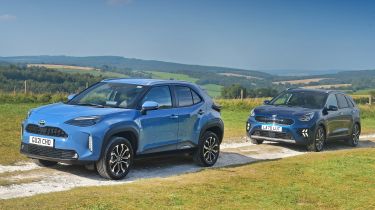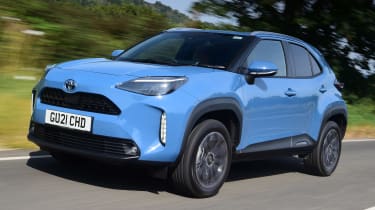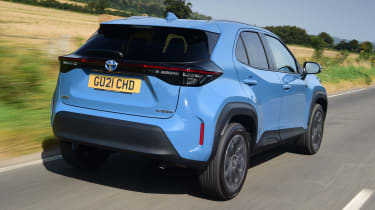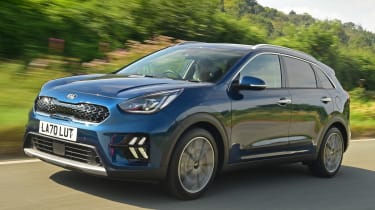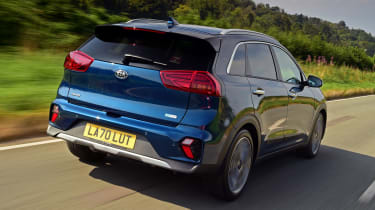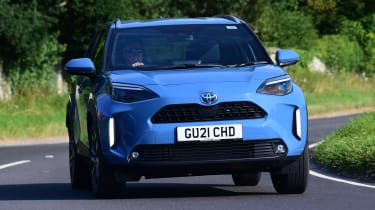Toyota Yaris Cross vs Kia Niro: 2021 group test review
The new Toyota Yaris Cross small SUV faces a serious rival in the form of the freshly revised Kia Niro
Plenty of car companies could lay claim to creating the small SUV class, but Toyota has some pretty strong credentials. The original RAV4 arrived in 1994, and it was one of the first cars of the era to deliver rugged styling and practicality in a relatively compact package.
It was a hit for Toyota, but over time the RAV4 has grown in size, so Toyota has bolstered its SUV range to compensate. First it introduced the C-HR as a smaller alternative, but with the explosion in popularity of supermini-based SUVs, the company needed another model on its books.
Enter the Toyota Yaris Cross, which has just gone on sale. The new model shares more than just a name with Toyota’s award-winning supermini, because its platform and running gear are identical, too. That means hybrid drive is standard, which should help it to deliver low everyday running costs.
With petrol-electric power central to its appeal, the Yaris Cross offers something different in the small SUV class, but it’s not a unique format in the sector. While the Kia Niro now comes with electric or plug-in power, it arrived as a hybrid in 2016. Constant development has refined and improved it over the years, but does it do enough to show hybrid specialist Toyota the way? There’s only one way to find out.
Toyota Yaris Cross
| Model: | Toyota Yaris Cross 1.5 VVT-i Design |
| Price: | £24,140 |
| Engine: | 1.5-litre petrol hybrid, 116bhp |
| 0-62mph: | 11.2 seconds |
| Test economy: | 56.1mpg/12.3mpl |
| CO2: | 102g/km |
| Annual road tax: | £145 |
The Yaris Cross is the smallest model in Toyota’s SUV line-up. It slots below the C-HR, starts from £22,515 and is around £3,000 more, model for model, than the Yaris supermini. Here we’re testing the Design model, which sits in the middle of the range and costs £24,140.
Design & engineering
Like the supermini of the same name, the Yaris Cross uses Toyota’s TNGA-B platform, and UK models are built in the same French factory as the hatchback, too.
Used - available now

2023 Honda
Jazz
13,611 milesAutomaticPetrol1.5L
Cash £17,995
2023 Tesla
New Model Y
16,397 milesAutomaticElectric
Cash £29,750
2020 Toyota
Yaris Hybrid
21,949 milesAutomaticPetrol1.5L
Cash £13,495
2022 Volvo
XC40
35,708 milesAutomaticPetrol1.5L
Cash £27,700There’s one powertrain option available, which again is the same one found in the Yaris: Toyota’s 1.5 VVT-i hybrid set-up with a three-cylinder petrol engine, electric motor, compact battery, CVT gearbox and front-wheel drive. There’s a modest 116bhp on offer, but that’s adequate for a model such as this.
On the outside, the Yaris Cross foregoes the supermini’s curves for a chunkier look. It rides 30mm higher than the supermini, and the off-road appearance is further emphasised by the gaps between the wheels and the arches. There are the usual additions of black plastic cladding and silver roof rails, while Design trim comes with chunky-looking 17-inch diamond-cut alloy wheels. Our car’s Urban Blue paint is a £250 option, while higher-spec versions can be had with a contrasting black roof.
Inside, there are clear similarities between the Yaris and Yaris Cross. The dashboard is pretty much identical, with the same switchgear, steering wheel, air vents and touchscreen infotainment system in place. You get heavily sculpted door cards that add a touch of flair to the cabin’s appearance, while silver trim around the gearlever and a piano-black finish for the curved section above the climate controls give the cabin a bit of a lift.
Go for mid-spec Design trim and you get a fairly healthy selection of kit. Climate control, a reversing camera, LED headlights, a digital dashboard and smartphone connectivity are all included, while our car was fitted with Toyota’s nine-inch infotainment system, a £500 upgrade in place of the standard eight-inch set-up. However, the only other options on offer are paint; if you want more kit, then you need to move up to another grade.
Driving
As with any Toyota hybrid, press the starter button in the Yaris Cross when there’s even a small amount of charge in the battery, and you’re greeted by a beep from the dashboard, the word “READY” illuminated in green in the dials, and absolute silence.
Toyota has years of hybrid experience and the transition from electric drive to petrol assistance is smooth in the Yaris Cross. At low speeds the car favours electric drive as much as it can, and when its engine cuts in, there’s a remote hum from under the bonnet, and the switch is smooth. Go faster and that engine becomes more vocal, with a familiar thrum from the odd number of cylinders. It’s not intrusive, though, and actually gives the Yaris Cross a bit of a sporty flavour.
That’s not to say that the car is quick. A 0-62mph time of 11.2 seconds is similar to the Niro’s 11.1-second 0-60mph figure, so while the Yaris Cross has enough power to keep pace with traffic, it’s not going to set the world alight.
A 200kg weight saving when compared with the Niro helps the car’s performance, while the Toyota feels agile in bends, too. There’s not much lean in corners, the Yaris Cross feels stable, and the driving position gives you that SUV-style view.
Unfortunately, comfort isn’t a strong point. Although the ride is reasonable at low speeds – better than the Kia’s – the faster you go, the worse it gets. Rough stretches make the car fidget, while different road surfaces have a major impact on cabin noise. Concrete motorways are especially bad.
Practicality
A tall, narrow body means the Yaris Cross is undeniably compromised inside. While space up front is fine, storage isn’t so great. The heavily sculpted door cards feature awkwardly shaped bins that make it easy to lose smaller items inside, while the centre console only has a couple of modest trays.
Access to the back seat is a bit of a fiddle, because of the narrow door openings and curved roofline, and once you’re in there you’ll find it’s a squeeze for three. The middle seat is particularly narrow, while legroom is in short supply.
That won’t be so bad if you’re only carrying kids in the rear seats on occasion, but there are further disappointments in the back. There’s no interior lighting for the rear seats, while the Yaris Cross comes with a flimsy fabric parcel shelf as a load cover. The back seats fold 40:20:40, but you need to move to a higher trim to get a false boot floor, which provides hidden storage and a level load lip.
Ownership
Buy a Toyota and, according to owners who got in touch with us via the Driver Power ownership survey, you’re pretty much assured of excellent customer service. However, you might have an even better experience from Kia. The Korean brand came second in our 2021 manufacturer ranking, while Toyota finished fifth. It’s a similar story in terms of dealer satisfaction, with these two ranking third and sixth respectively.
Running costs
We managed a respectable 56.1mpg in the Yaris Cross, and it’s impressive how often the car runs on electric drive alone; there’s a small EV logo in the dash that illuminates to show you that you’re doing exactly that.
A “B” mode on the gearbox offers some extra resistance to plough back more energy, although we found the engine was more eager to fire up in this mode, which cancels out any benefit it might offer.
Testers’ notes: “The Yaris Cross has that rare small SUV option of four-wheel drive. The part-time set-up adds £2,360 to the price of Dynamic or Premiere Edition models.”
Kia Niro
| Model: | Kia Niro 1.6 GDi 2 |
| Price: | £25,405 |
| Engine: | 1.6-litre petrol hybrid, 139bhp |
| 0-62mph: | 11.1 seconds |
| Test economy: | 50.6mpg/11.1mpl |
| CO2: | 110g/km |
| Annual road tax: | £145 |
While not as firmly established as the Toyota Prius, the Kia Niro “self-charging hybrid” has been a staple of the class since 2016. It’s in the middle of a range update, so buy one today and you’ll get a 2022-model-year car with the latest Kia badging. Here, we’re testing the entry-level Niro 2, although the car in our pictures is a top-spec Niro 4.
Design & engineering
While the Kia Niro has spawned plug-in hybrid and all-electric variants, this is where it all started, with the conventional “self-charging” hybrid. With hybridisation now prevalent across all areas of the new-car market, the Niro’s transmission isn’t as innovative as it once was. It’s largely the same as the Yaris Cross’s set-up, albeit with a larger 1.6-litre four-cylinder petrol engine joining the electric motor and battery, while a six-speed twin-clutch automatic is used where the Toyota has a CVT auto. There’s no four-wheel-drive option, so all Niros are front-wheel drive, while the system’s output of 139bhp is well ahead of the Toyota’s 116bhp.
Lined up next to the Yaris Cross, the Kia looks more like a hatchback than an SUV. It has the same off-road styling cues, such as plastic wheelarch extensions and silver roof rails, but it’s longer, lower and wider than its rival here, and it doesn’t have as much ground clearance, either.
The payoff is that there is more space inside, with plenty of shoulder room in the back, a bigger boot and lots of cabin storage, including a bin under the wide central armrest. Build quality feels solid inside, too, while the switchgear is robust and the mix of touchscreen and physical controls is good.
Like the Yaris Cross in Design spec, the entry-level Niro 2 is reasonably well equipped. You get a full suite of safety kit, while two-zone climate control, a multifunction steering wheel, adaptive cruise control, auto lights and wipers, and a rear camera and parking sensors are all included.
Driving
Sit in the Niro and it feels more like a hatchback than an SUV from behind the wheel, with a lower driving position than in the Yaris Cross. The hybrid system acts in the same way as the Toyota’s, so the engine won’t necessarily fire up when you turn on the ignition. When it does start, the four-cylinder unit cuts in smoothly, compared with the slightly harsher thrum of the Toyota’s triple, although neither car could be considered noisy.
While the Niro has a 23bhp power advantage over the Yaris Cross, you can’t feel it on the road. The car’s extra weight means acceleration is similar, although the Kia works its way through the twin-clutch automatic gears as it builds speed, whereas the Toyota’s CVT lets the revs soar as it gets going.
The Niro isn’t an exciting car to drive. It gets you from A to B with the minimum of fuss, but there’s little enjoyment in the experience.
While it’s not very sporty, the Niro does have gearbox paddles behind the steering wheel. In Normal driving mode, the paddles increase or decrease the amount of resistance the car applies when you lift off the throttle, which will help boost efficiency. This set-up works well, and although the strongest setting isn’t powerful enough to allow you to engage in single-pedal driving, you’ll certainly be using the brakes less often.
Switch to Sport mode, and you can take control of gearshifts, as you would in a DCT-equipped sports car. It feels like overkill in the Niro, though, because nothing else about the car feels particularly sporty.
The Niro’s ride is more unsettled than the Yaris Cross’s, and is quick to fidget and shimmy over rough tarmac, but go faster and the Niro improves. The ride is smoother than it is in the Yaris Cross on the motorway, although it’s still on the firm side, while the Kia isn’t as sensitive to surface changes and remains quieter at higher cruising speeds.
Practicality
It’s a larger car, so you would expect the Niro to have an advantage in terms of practicality. It actually has a smaller boot in five-seat mode, but it’s the little things that set the Kia apart. The boot has a proper extendable load cover, while the floor feels solid and there are storage trays underneath, whereas the Toyota has a painted metal wheel well under a flimsy boot carpet.
As already mentioned, passenger space in the back is fine, and there’s good legroom, too. Another bonus is that there is LED lighting in the back, plus larger rear windows and twin air-vents, giving passengers a greater sense of space and comfort.
Ownership
The Kia Niro earned a five-star Euro NCAP crash test rating when it first arrived in 2016. The Yaris Cross has yet to be tested, but it has the same safety kit as the Yaris supermini, which earned a five-star rating in 2020 in a tougher test than the Niro’s.
The good thing about the Niro is that all versions get almost the same safety kit. Adaptive cruise, autonomous emergency braking and lane-keep assist are all included; the only omissions on entry models are speed-limit warning and blind-spot detection with rear cross traffic alert.
Running costs
Company car tax is lower for these cars than it is for conventional petrol models, and here the Yaris Cross has the edge over the Niro. Emissions of 102g/km put the Toyota in the 24 per cent Benefit in Kind bracket, compared with the Niro’s 26 per cent banding. Factor in a lower P11D price, and the Toyota is the cheaper company car choice.
However, you’ll save even more by going for a plug-in or all-electric Niro, which are options that the Toyota range is unable to offer.
Testers’ notes: “Two-zone climate control comes with a ‘driver-only’ button, which shuts down the system to the rest of the car when there’s one person on board.”
Verdict
First place: Kia Rio
As a practical family hybrid car, the Kia Niro fits the brief perfectly. There’s room for five on board, plenty of storage and the petrol-electric drivetrain gets on with the job with the minimum of fuss. It’s not a very exciting car to drive, but it delivers a relaxing experience, while even the entry-level model has more than enough kit as standard to make it look good value for money.
Second place: Toyota Yaris Cross
There’s lots to like about the Yaris Cross. It’s great in town, where its nimble handling and efficient hybrid system come into their own, while the car will be practical enough for two. However, add any more passengers, and its limited space holds it back, while in some places the car has been built down to a price. It hits back with strong finance offers, though.
Is it worth waiting for this model?
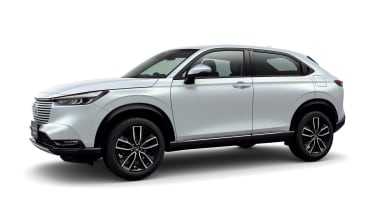
- Due: Autumn
- Price: £26,960
- Engine: 1.5-litre hybrid, 106bhp
Another manufacturer embracing hybrid drive is Honda. The new HR-V uses running gear seen in the Jazz. It’ll be a little pricier than its rivals here, but should be a practical choice and returns a claimed 52.3mpg.
Figures
| Kia Niro 1.6 GDi 2 | Toyota Yaris Cross 1.5 VVT-i Design | |
| On the road price/total as tested | £25,405/£25,405 | £24,140/£24,890 |
| Residual value (after 3yrs/36,000) | £12,499/49.2% | £13,422/55.6% |
| Depreciation | £12,906 | £10,718 |
| Annual tax liability std/higher rate | £1,310/£2,621 | £1,149/£2,298 |
| Annual fuel cost (12k/20k miles) | £1,460/£2,433 | £1,317/£2,194 |
| Insurance group/quote/VED | 11/£520/£145 | 12/£510/£145 |
| Cost of 1st/2nd/3rd service | £489 (3yrs) | £190/£190/£190 |
| Length/wheelbase | 4,355/2,700mm | 4,180/2,560mm |
| Height/width | 1,545/1,805mm | 1,595/1,765mm |
| Engine | 4cyl hybrid/1,580cc | 3cyl hybrid/1,490cc |
| Peak power/revs | 139/5,700 bhp/rpm | 116/5,500 bhp/rpm |
| Peak torque/revs | 265/4,000 Nm/rpm | 120/3,600 Nm/rpm |
| Transmission | 6-spd auto/fwd | CVT auto/fwd |
| Fuel tank capacity/spare wheel | 45 litres/repair kit | 36 litres/repair kit |
| Boot capacity (seats up/down) | 382/1,380 litres | 397/1,097 litres |
| Kerbweight/payload/towing weight | 1,490/440/kg | 1,290/485/kg |
| Turning circle | 10.6 metres | 10.6 metres |
| Basic warranty (miles)/recovery | 7yrs (100k)/1yr | 3yrs (60k)/1yr |
| Driver Power manufacturer/dealer pos | 2nd/3rd | 5th/6th |
| NCAP: Adult/child/ped./assist/stars | 83/80/57/59/4 (‘16) | N/A |
| 0-62mph/top speed | 11.1 secs*/101mph | 11.2 secs/105mph |
| Auto Express econ (mpg/mpl)/range | 50.6/11.1/501 miles | 56.1/12.3/444 miles |
| WLTP combined | 58.9mpg** | 54.3-64.1mpg |
| WLTP combined | 13.0mpl** | 5.2-4.4mpl |
| Actual/claimed CO2/tax bracket | 129/110g/km**/26% | 116/102g/km/24% |
| Airbags/Isofix/park sensors/camera | Seven/yes/yes/yes | Seven/yes/no/yes |
| Auto box/lane keep/blindspot/AEB | Yes/yes/no/yes | Yes/yes/no/yes |
| Climate control/adaptive cruise | Yes/yes | Yes/yes |
| Leather/heated seats | No/no | No/no |
| Metallic paint/LED lights | £595/yes | £585/yes |
| keyless entry & go/power tailgate | No/no | Yes/no |
| Sat-nav/digital dash | No/no | £500/yes |
| DAB radio/connected services | Yes/no | Yes/£500 |
| Wireless charge/CarPlay/Android Auto | No/yes/yes | No/yes/yes |
